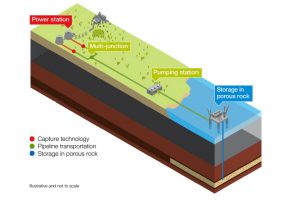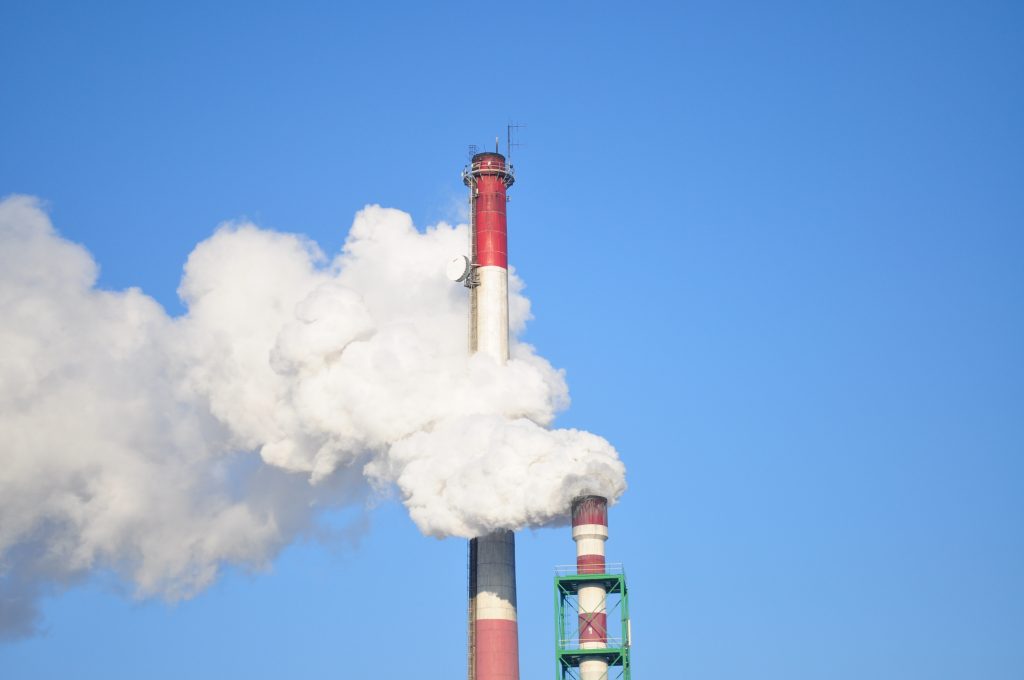Carbon Capture and Storage, what is it and how does it work?
Many analyses investigating how to reach climate goals include carbon capture and storage (CCS) if we are to reduce emissions quickly enough to avoid the worst impacts of climate change. This column takes a look at what this process is.
In short, CCS is the process of capturing carbon from the emitting source (like a power plant) before it reaches the atmosphere, then injecting the carbon deep underground where it is trapped in geological formations. This allows the continued use of fossil fuels with greatly reduced carbon emissions. Electric power production and industry account for half of the United States’ greenhouse gas emissions, providing much potential for CCS to help reduce carbon emissions into the atmosphere.
Carbon captured at the source is compressed into a liquid-like state that allows it to be transported to a storage site. Transport is typically via pipeline, but can also be done via ship, rail or truck.

The basic concept of geologic storage is that the liquified carbon is injected into geological formations with space that can hold liquid, trapping the injected carbon below ground. Once injected, the carbon is prevented from escaping back into the environment by 1) being trapped by an impermeable rock layer above the storage formation, 2) dissolving into existing fluid in the formation, or 3) forming mineral deposits on surrounding rock.
Storage formations are very deep (greater than 3,300 feet) since natural temperatures and pressures at this depth allow the carbon to remain in a liquid form and maintain a separation from drinking water supplies.
Three primary geologic formations are being targeted for carbon sequestration. Deep saline reservoirs contain salty water that carbon can be injected into. Such formations are thought to have the greatest potential volume for carbon storage in the United States. However, leakage potential is not well understood and there could be issues associated with displacing the existing fluid.
Oil and gas reservoirs are also targeted as storage sites since the pore space in the formations that previously held fossil fuels is well suited to now hold carbon. Since these formations previously kept the fossil fuels trapped for millions of years, there’s less risk of carbon leakage from these formations.
Coal seams that cannot be mined are the third primary formation targeted for carbon storage. These are coal deposits that cannot be mined for technical or economic reasons. These seams are permeable and carbon can bind to the coal, permanently trapping it below ground. However, this process will often displace methane which is commonly found in coal seam pores, which would need to be collected since it is a more potent greenhouse gas than carbon.
None of these three main storage formations are thought to occur in Wisconsin. However, two other formations with more limited potential do occur in Wisconsin. Organic shale deposits and basalt formations are other geologic structure with carbon storage potential in the United States. Organic shale deposits operate on the same principle as coal seams and are found in southeastern Wisconsin. The chemical properties of basalt could allow injected carbon to mineralize, permanently locking the carbon below ground. There are some basalt formations in northwest Wisconsin.
The United States has an estimated 3,000 gigatons of carbon storage potential. For context, in 2020, the United States emitted about 5 gigatons of carbon. The latest Intergovernmental Panel on Climate Change assessment indicated that to keep warming under 2°C, we will need to store about 665 gigatons of carbon by 2100, which works out to about 8 gigatons of carbon per year on average. However, worldwide, currently less than 0.05 gigatons of carbon is being captured and stored annually. A major barrier is lack of economic incentive to take on these expensive projects.
Concerningly, in the United States most of the current CCS is used in enhanced oil recovery, which does provide economic incentive for its use. In this process, captured carbon is used to create pressure that helps extract fossil fuels. While the injected carbon is stored, the extracted fossil fuels are burned, creating new carbon emissions that minimize or even negate climate benefits of the storage. For CCS to play a meaningful role in combating climate change, it will need to be greatly scaled up and occur in contexts where new fossil fuels are not being extracted in the storage process.
Whether, and to what extent, CCS should play a role in our climate response is a whole new discussion, but some bigger concerns are worth noting here. An obvious concern is that CCS prolongs our dependence on fossil fuels and delays the transition to clean energy and a truly sustainable future. Capture is energy intensive, requiring the source to burn even more fossil fuel to capture the carbon at the expense of emitting greater quantities of other harmful air pollutants. Carbon transport will most likely require development of a pipeline network with environmental impacts and public safety risks in the event of pipeline leaks. There are outstanding questions about how well underground storage will avoid leakage back out into the atmosphere, as well as geologic consequences of injecting huge quantities of liquid underground (e.g., injection-induced earthquakes) and the potential for drinking water aquifer contamination.
It’s also important to keep in mind that CSS discussed here only prevents the release of new carbon into the atmosphere. To reach climate goals, most analyses indicate that negative carbon emissions—or the removal of carbon already in the atmosphere—is needed. Technology to remove carbon from the air and store it underground as described here is an option for negative emissions, but natural climate solutions are another way to reduce carbon in the atmosphere, and they offer a host of additional environmental benefits. Planting trees and deep-rooted perennials not only pulls carbon from the atmosphere, it also helps prevent soil runoff, increases soil health and can reduce water pollution. While carbon capture storage technology offers promise, storing carbon the natural way is something we can do to address the climate crisis today.

